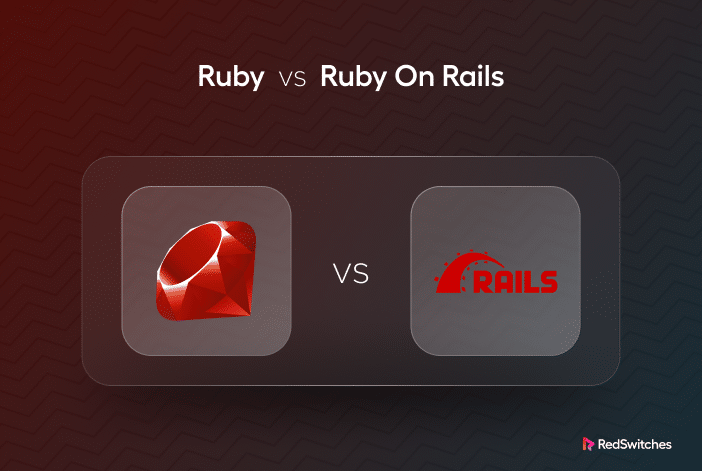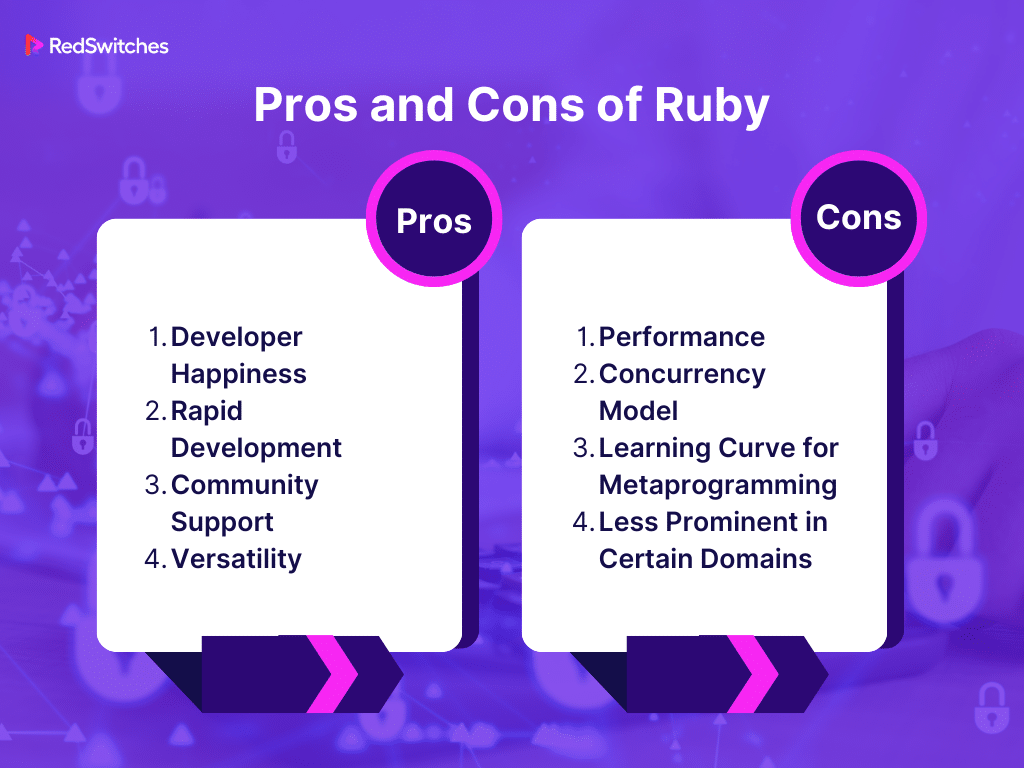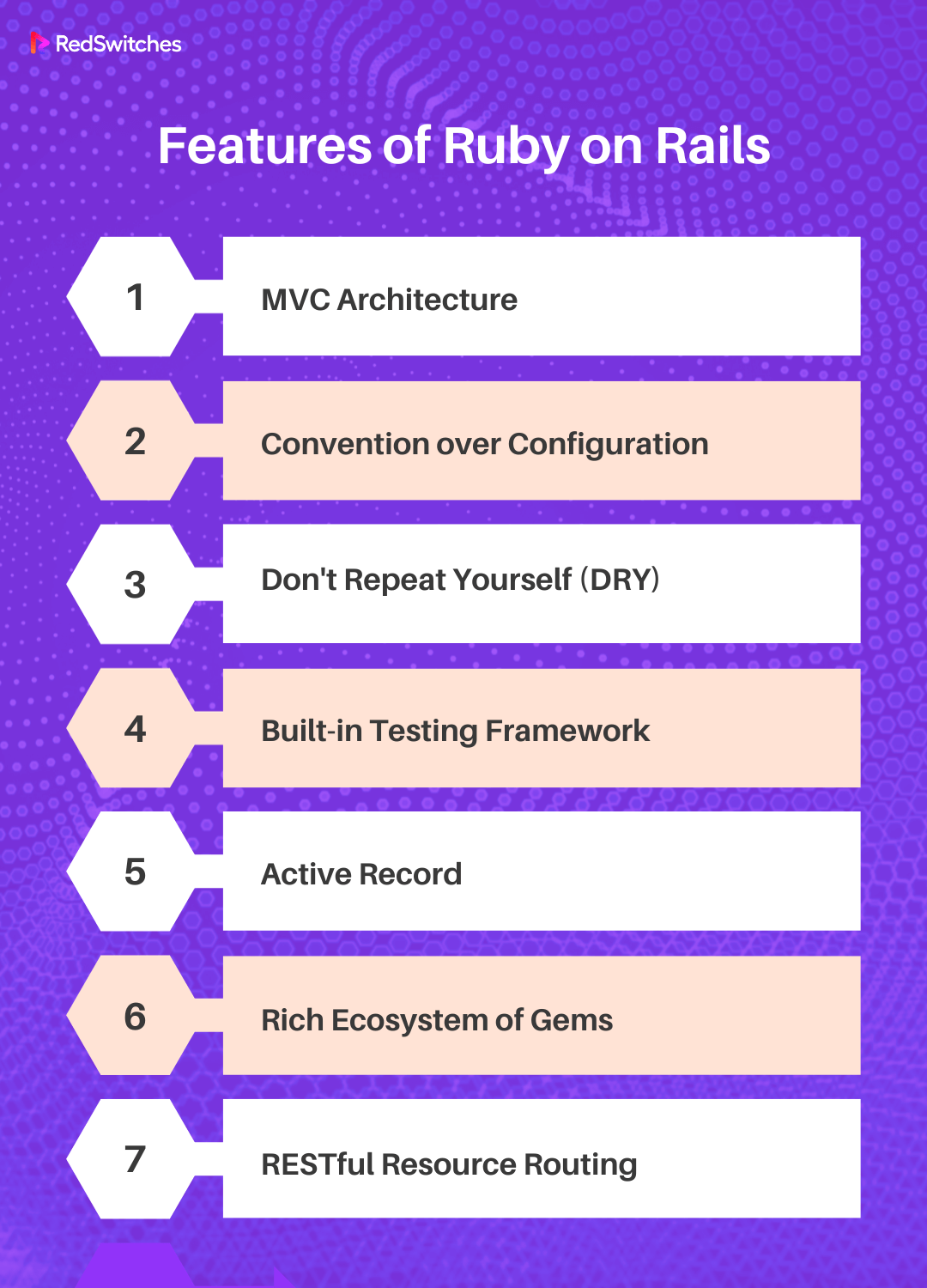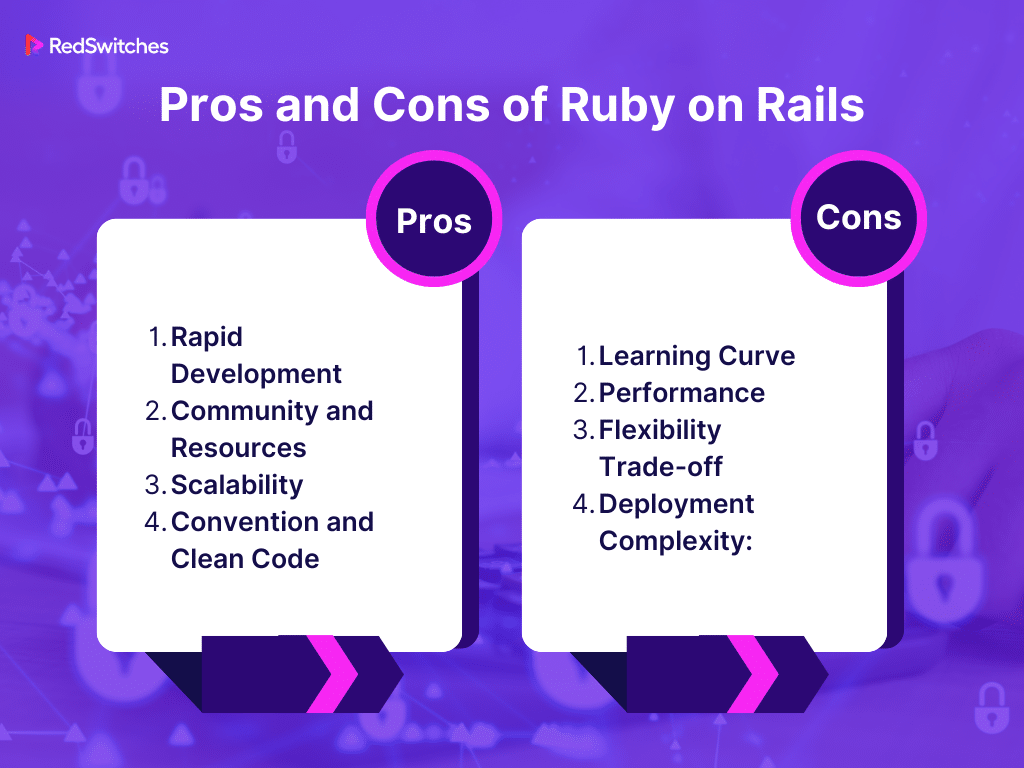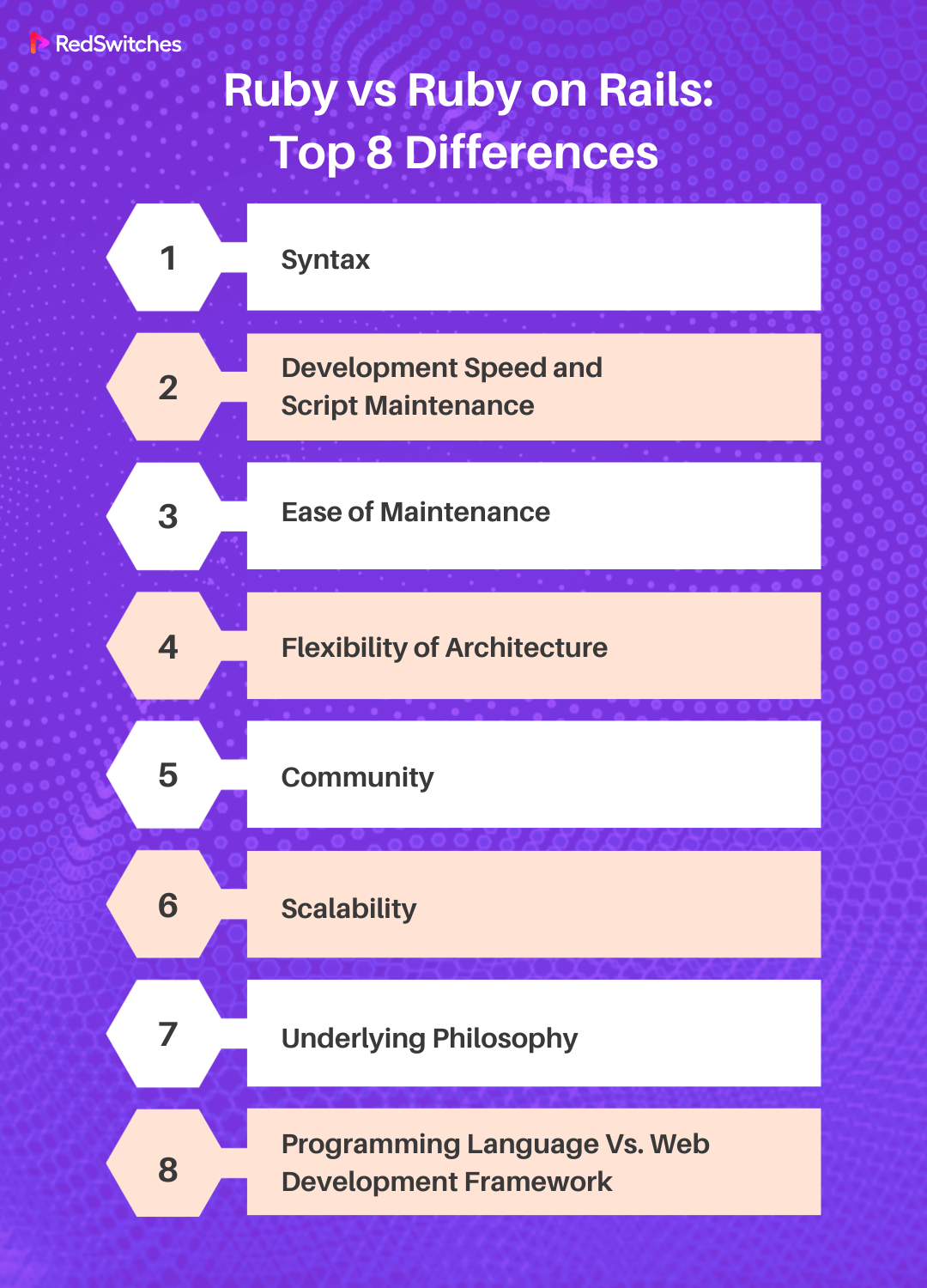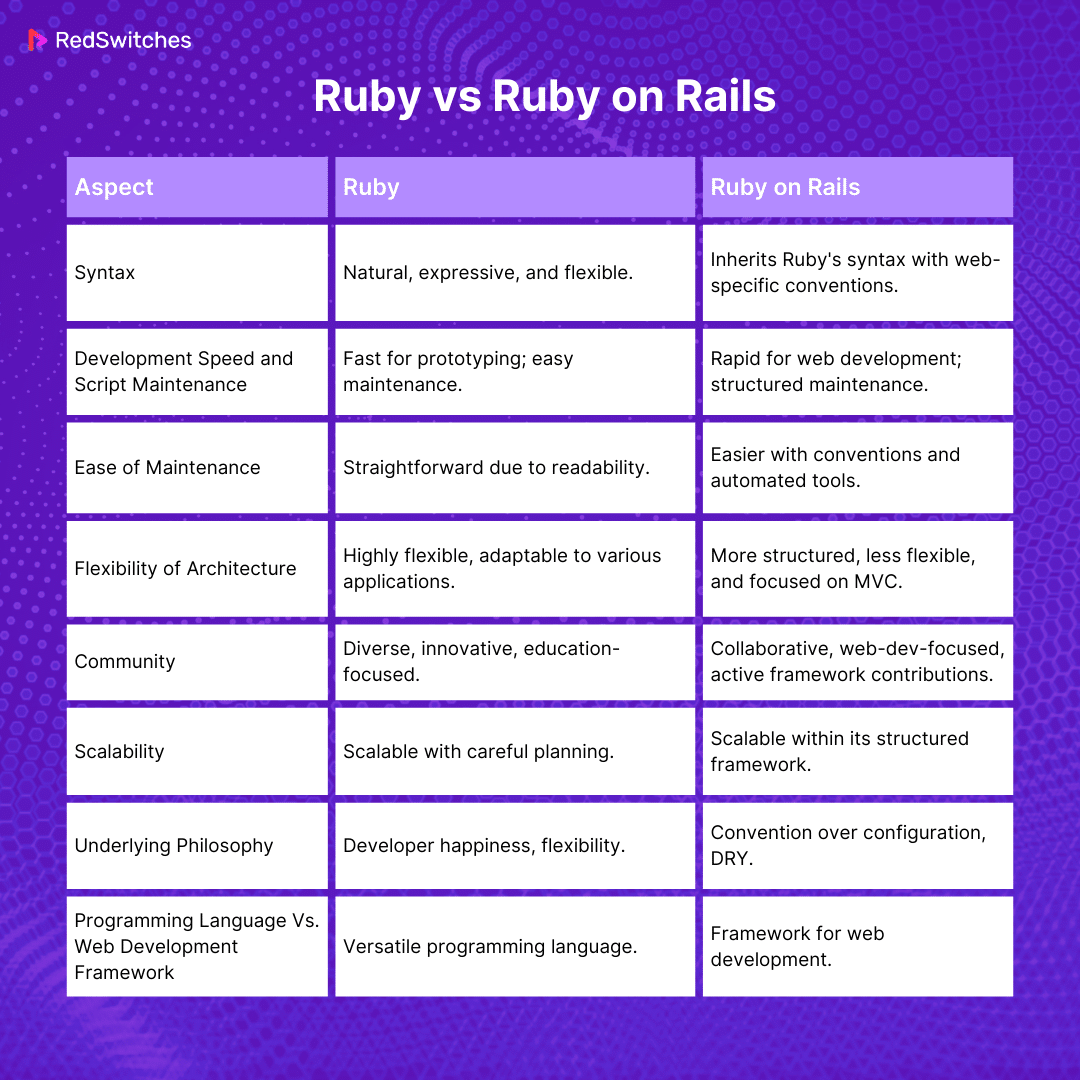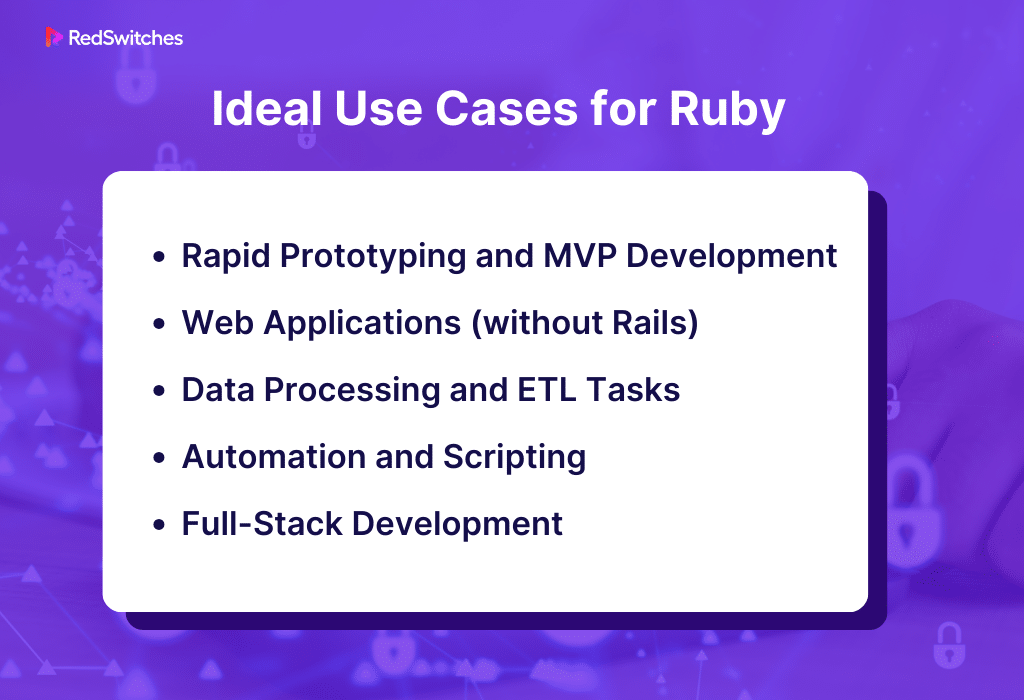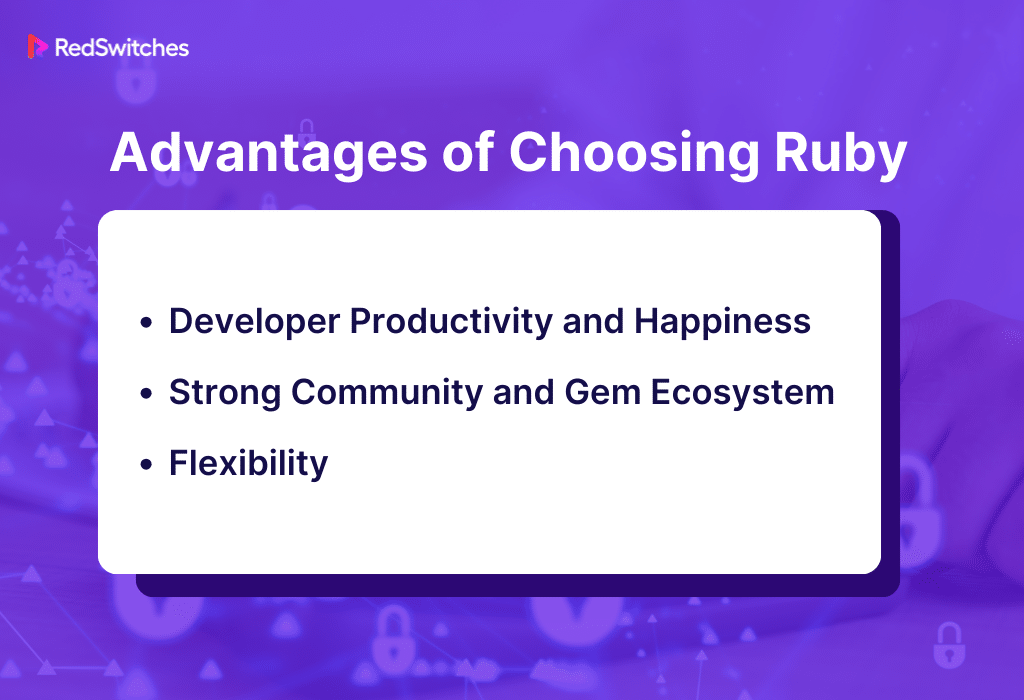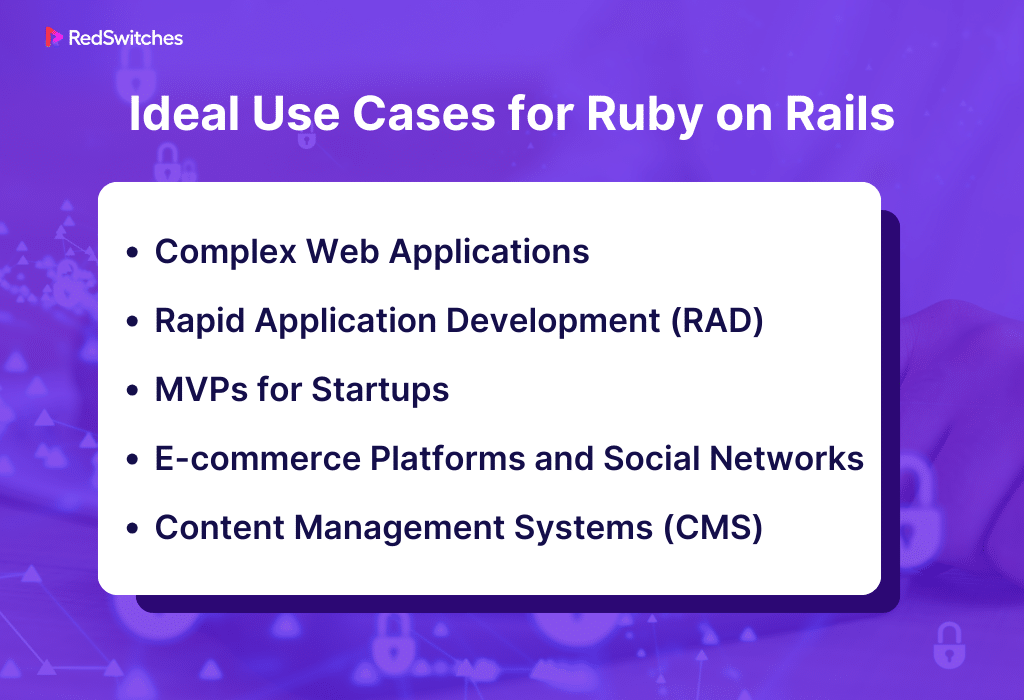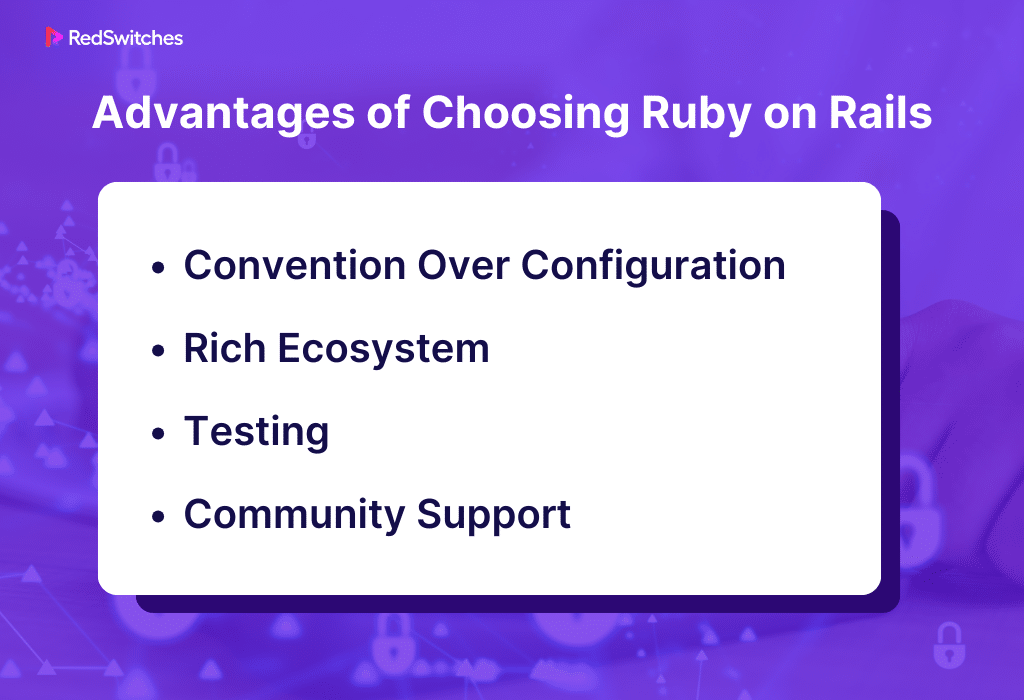In the vibrant programming universe, the distinction between Ruby vs Ruby on Rails often sparks curiosity and confusion. While they share a linguistic root, their identity and role in the tech ecosystem are distinct, each playing a crucial part in modern software development. This exploration is about contrasting a language with a framework and understanding how each empowers developers uniquely.
Ruby, created by Yukihiro Matsumoto in the mid-1990s, is a language celebrated for its elegance and simplicity. It’s designed to focus on productivity and joy, making coding a less daunting and more intuitive experience. On the other hand, Ruby on Rails, often just called Rails, is a web application framework written in Ruby. It’s the brainchild of David Heinemeier Hansson and emerged as a beacon for web development, advocating convention over configuration and the DRY (Don’t Repeat Yourself) principle.
Join us as we unravel the eight essential differences between Ruby vs Ruby on Rails, shedding light on their strengths, applications, and how they collectively contribute to the tapestry of software development.
If you’re intrigued by the capabilities of Ruby vs Ruby on Rails and looking to expand your knowledge in the broader realm of web development, don’t miss our comprehensive guide, “15 Best PHP Frameworks for Web Development in 2023: A Guide For Newbies & Experts”.
Table of Contents
- What is Ruby?
- What is Ruby on Rails?
- Ruby vs Ruby on Rails: Top 8 Differences
- When To Use Ruby?
- When To Use Ruby on Rails?
- Conclusion
- FAQs
Credits: Freepik
What is Ruby?
At the heart of many innovative software solutions lies Ruby, a language that blends artistry with technology. Designed to make programming both fun and easy, Ruby stands out in the programming world for its unique philosophy and approach.
Features of Ruby
Ruby’s charm lies in its features, carefully crafted to enhance developer experience and efficiency:
- Object-Oriented Nature: Imagine a world where everything can be an object, from numbers to true or false values. Ruby turns this into reality, embracing a pure object-oriented approach that simplifies the conceptualization and manipulation of data.
- Flexibility and Freedom: Ruby’s rules aren’t set in stone. It empowers developers with the flexibility to bend and reshape the language to suit their unique needs, fostering creativity and innovation.
- Elegant Syntax: Ruby’s syntax is its poetry. It’s designed to be natural and almost conversational, which makes writing and reading code a breeze.
- Dynamic Typing and Duck Typing: Ruby trusts you to know what you’re doing. It offers dynamic typing and follows the “if it quacks like a duck” principle, allowing for more freedom and less boilerplate code.
- Mixins through Modules: Instead of multiple inheritances, Ruby uses mixins, providing a robust and manageable way to add class functionality.
- Powerful Metaprogramming: Ruby’s metaprogramming capabilities are legendary, allowing programs to alter themselves while running, and fostering extreme flexibility.
- Large Standard Library and Gems: Ruby has an extensive standard library and a treasure trove of gems, meaning you rarely have to reinvent the wheel.
Pros and Cons of Ruby
As with any language, Ruby has its shining moments and its challenges:
Pros:
- Developer Happiness: Ruby is designed with the developer’s happiness in mind, making it enjoyable to use.
- Rapid Development: Thanks to its simplicity and the wealth of libraries available, Ruby facilitates rapid development and prototyping.
- Community Support: Ruby boasts a vibrant, supportive community, which translates into a wealth of resources, libraries, and tools.
- Versatility: Ruby’s versatility makes it a fit for various projects, from web applications to data analysis.
Cons:
- Performance: Ruby can be slower than C++ or Java, especially in intensive CPU processing scenarios.
- Concurrency Model: Ruby’s concurrency model, with its Global Interpreter Lock (GIL), is often seen as a limitation in multi-threaded applications.
- Learning Curve for Metaprogramming: While powerful, Ruby’s metaprogramming can be complex for beginners.
- Less Prominent in Certain Domains: Ruby is less dominant in desktop application development or systems programming.
In sum, Ruby is a language that prioritizes the developer’s experience and productivity, offering an expressive, flexible syntax and a supportive community. It shines in rapid development environments but may face challenges in scenarios demanding high performance or complex concurrency.
What is Ruby on Rails?
Diving into web development, Ruby on Rails (often simply called ‘Rails’) emerged as a superstar. It’s not just any framework; it’s a full-stack web application framework that extends Ruby’s philosophy into the web, making building complex websites simpler and more enjoyable.
Features of Ruby on Rails
Rails is known for its “convention over configuration” approach. Here’s why it stands out:
- MVC Architecture: Rails is based on the Model-View-Controller (MVC) architecture, promoting a clean separation of concerns – an organizational boon for developers.
- Convention over Configuration: Rails favors convention, meaning less time spent configuring files and more time building features. It’s about smart defaults that work out of the box.
- Don’t Repeat Yourself (DRY): Rails encourages writing DRY code, reducing repetition and making maintenance easier.
- Built-in Testing Framework: Testing is not an afterthought in Rails; it’s part of the culture. The framework has a built-in testing suite, making test-driven development (TDD) more accessible.
- Active Record: This feature simplifies database interactions by mapping tables to classes and rows to objects, making database manipulations intuitive and efficient.
- Rich Ecosystem of Gems: Rails has a rich ecosystem of ‘gems’ (libraries), extending its functionality and speeding up development.
- RESTful Resource Routing: Rails makes it easy to adhere to RESTful principles, streamlining the creation of routes and actions in your application.
Pros and Cons of Ruby on Rails
Even with its impressive features, Rails, like any technology, has its advantages and drawbacks:
Pros:
- Rapid Development: Rails is about making development faster and more efficient, significantly reducing the time from conception to launch.
- Community and Resources: The Rails community is vibrant and resource-rich, providing a plethora of plugins, modules, and learning materials.
- Scalability: While often debated, Rails can be scalable, powering some of the biggest platforms like Shopify and Airbnb.
- Convention and Clean Code: Rails’ emphasis on convention and clean code helps maintain consistency and understandability across projects.
Cons:
- Learning Curve: The ‘magic’ of Rails can be overwhelming for beginners, with its convention-over-configuration approach requiring a solid understanding of its conventions.
- Performance: Rails applications can be resource-intensive compared to frameworks in languages like Go or Elixir.
- Flexibility Trade-off: The convention-heavy approach of Rails can sometimes limit flexibility, making it less suitable for projects that require a significant departure from standard practices.
- Deployment Complexity: Setting up and deploying a Rails application can be more complex compared to simpler scripting languages or frameworks.
Ruby on Rails is a powerhouse for web development, matching Ruby’s elegance and productivity with robust web application-building capabilities. It excels in creating complex, database-backed web applications but may present challenges in performance and flexibility in specific scenarios.
Also Read: How to Install Ruby on Ubuntu 22.04
Ruby vs Ruby on Rails: Top 8 Differences
Navigating the landscape of modern programming, it’s crucial to distinguish the nuances and capabilities of popular tools. In the spotlight are Ruby vs Ruby on Rails – two names that often intertwine yet stand apart in their essence and utility.
Understanding the top 8 differences between Ruby, a dynamic and elegant programming language, and Ruby on Rails, a robust and convention-driven web application framework, is more than an academic exercise.
It’s about comprehending the tools that shape digital solutions, influence developer workflows, and drive technological innovation. This comparison is a journey through the realms of simplicity, productivity, and efficiency, illuminating the distinct paths each takes in the vast world of software development.
Syntax
Credits: Freepik
In the context of programming languages and frameworks, “syntax” refers to the rules and guidelines that define how to write code correctly so that it can be understood and executed by a computer. Syntax encompasses the structure of code, the use of various symbols and keywords, and how elements like functions, variables, loops, and conditional statements are formulated and organized. Let’s analyze syntax distinctions in a debate of ruby vs ruby on rails.
Ruby:
- Expressive and Minimalist: Ruby’s syntax is celebrated for its expressiveness and minimalist design. It allows for writing self-explanatory code that often reads like natural language.
- Flexibility: Offers excellent flexibility, enabling developers to craft solutions in multiple ways while maintaining readability.
- Less Boilerplate Code: Typically requires less boilerplate code, making it more concise than many other programming languages.
Ruby on Rails:
- Convention-driven: Inherits Ruby’s syntax but emphasizes convention over configuration, streamlining coding for web development.
- DSL for Web Development: Features a Domain Specific Language (DSL) for routes, database migrations, and more, optimizing it for web development tasks.
- Structured Approach: Encourages a more structured approach in coding, with specific rules and patterns that are consistent across Rails applications.
Also Read: How Much Do Websites Cost To Develop In 2024?
This delineation highlights how Ruby offers a broad canvas for expressive coding, while Rails refines this into a more structured and specialized toolkit for web development.
Development Speed and Script Maintenance
Credits: Freepik
In the dynamic world of software development, speed and ease of maintenance are critical factors in choosing a language or framework. While stemming from the same root, Ruby vs Ruby on Rails offers distinct advantages in these areas, each tailored to specific projects and development philosophies.
Ruby:
- Quick Prototyping: Ruby excels in rapid prototyping, allowing developers to turn ideas into working scripts quickly.
- Ease of Maintenance: The clarity of Ruby’s syntax simplifies the maintenance and updating of scripts, making it a preferred choice for projects where long-term code manageability is key.
- Flexibility for Changes: Ruby’s dynamic nature and flexible syntax are ideal for projects requiring frequent updates or iterative development.
Ruby on Rails:
- Accelerated Web Development: Rails is a powerhouse for web application development, significantly cutting down development time with its built-in tools and modules.
- Standardized Codebase: Rails ‘convention over configuration’ philosophy ensures a standardized codebase, making it easier for teams to maintain and scale web applications.
- Automated Tasks and Testing: With its emphasis on automated testing and tasks, Rails ensures that web applications remain robust and maintainable over time, even as they evolve and grow.
In essence, while discussing ruby vs ruby on rails regarding web development. Ruby shines in scenarios requiring rapid prototyping and flexible script maintenance. In contrast, Ruby on Rails is the go-to for fast-paced web development, focusing on long-term maintainability and scalability.
Ease of Maintenance
The ease with which a project can be maintained and updated over time is crucial in software development. Ruby vs Ruby on Rails addresses maintenance concerns differently, each with strengths and methodologies.
Ruby:
- Readable Code: Ruby’s clean and intuitive syntax contributes to highly readable code, making it easier for developers to revisit and understand code even after long periods.
- Flexibility for Refactoring: The language’s flexibility allows for seamless refactoring, which is essential for adapting and improving code over time.
- Strong Testing Culture: Ruby’s community strongly emphasizes testing, which helps maintain code quality and reduces the likelihood of bugs during updates.
Ruby on Rails:
- Convention Over Configuration: Rails’ adherence to conventions means that most applications follow a similar structure and coding practices, simplifying the process of understanding and updating the code.
- Built-in Tools for Maintenance: Rails provides numerous built-in tools and gems that automate and facilitate maintenance tasks, such as database migrations and testing.
- Active Development Community: The active Rails community continuously improves the framework, ensuring it stays up-to-date and secure, aiding in maintaining Rails applications.
While talking about Ruby vs Ruby on Rail’s ease of use maintenance, Ruby offers a flexible and intuitive environment conducive to easy maintenance. Ruby on Rails provides a structured and tool-rich framework that streamlines and standardizes the maintenance process, particularly for web applications.
Also, Read A Comprehensive Guide to Application Development Cloud Computing
Flexibility of Architecture
Credits: Freepik
The architectural flexibility of a programming language or framework is a key factor in determining its suitability for various project types and scales. Ruby vs Ruby on Rails offers contrasting levels of architectural flexibility, each aligning with different development needs and philosophies.
Ruby:
- Architectural Freedom: Being a language rather than a framework, Ruby offers immense architectural freedom. Developers can structure their applications as they see fit, choosing the design patterns and architectures that best suit their project’s needs.
- Adaptability: Ruby’s simplicity and versatility make it adaptable to various applications, from simple scripts to complex systems.
- Integration Friendly: Ruby’s flexibility extends to its ability to integrate with various databases, APIs, and other technologies, allowing for a diverse range of architectural designs.
Ruby on Rails:
- Opinionated Framework: Rails is often described as an “opinionated” framework. It has conventions and default structures, such as the MVC (Model-View-Controller) pattern. This reduces the flexibility in architectural design but speeds up development.
- Standardization: The standard architectural patterns in Rails are beneficial for collaborative projects and large teams, ensuring consistency and predictability in the codebase.
- Scalability Constraints: While Rails applications can be scaled, the framework’s opinionated nature may impose certain constraints, making it less flexible for highly unique or unconventional architectural requirements.
Ruby vs Ruby on Rails, regarding flexibility of architecture, Ruby offers the flexibility to experiment and tailor architecture to specific needs, making it ideal for projects requiring custom solutions. In contrast, Ruby on Rails provides a more standardized and streamlined approach, favoring rapid development and maintainability at the cost of some architectural flexibility.
Community
Credits: iStock
The community surrounding a programming language or framework is a vital resource for developers, offering support, resources, and continuous improvement. Ruby vs Ruby on Rails boasts active and vibrant communities, each contributing uniquely to their respective ecosystems.
Ruby:
- Diverse and Welcoming: The Ruby community is known for being diverse, welcoming, and supportive. It’s a community that values creativity and innovation, reflected in the vast array of gems (libraries) developed by its members.
- Global Reach: Ruby has a global presence with numerous local user groups and international conferences, facilitating knowledge sharing and networking.
- Focus on Education: There’s a strong emphasis on education within the Ruby community, with abundant resources available for beginners and advanced programmers.
Ruby on Rails:
- Highly Collaborative: The Rails community is characterized by its collaboration and active contribution to the framework’s development. This collaborative spirit is evident in Rails’ frequent updates and extensive documentation.
- Strong Online Presence: Rails has a robust online presence, with forums, blogs, and platforms like GitHub bustling with activity, discussions, and problem-solving.
- Commercial and Enterprise Adoption: Given Rails’ popularity for web development, significant commercial and enterprise involvement drives the framework’s growth and maturity.
In summary, while Ruby’s community thrives on diversity and a strong educational focus, making it welcoming for newcomers and seasoned developers alike, the Ruby on Rails community is marked by its collaborative nature and substantial involvement in the continuous evolution of the framework, benefiting from significant commercial support and enterprise adoption.
Scalability
Credits: iStock
Scalability is crucial in modern software development, determining how well a language or framework can adapt to increasing demands. Ruby vs Ruby on Rails approach scalability differently, each with inherent strengths and limitations.
Ruby:
- Language Flexibility: As a language, Ruby’s scalability largely depends on the architecture and design patterns employed in the application. Its flexibility allows for scalable solutions but requires careful planning and expertise.
- Performance Considerations: Ruby’s runtime can be a bottleneck in high-performance scenarios. However, with the right architectural choices and optimizations, Ruby applications can scale effectively.
- Community Support: The Ruby community provides a wealth of libraries and tools that can aid in scaling applications, though it often requires more manual intervention than other languages.
Ruby on Rails:
- Framework Limitations: Rails, being an opinionated framework, imposes certain conventions that can affect scalability. While it excels in rapid development, these conventions might need to be circumvented for highly scalable applications.
- Built for Scalability: Rails is designed with scalability in mind despite its limitations. Features like Active Record and Action Cable provide robust back-end support for scaling.
- Proven Track Record: Numerous high-traffic websites are built on Rails, demonstrating its ability to scale. However, scaling a Rails application often involves leveraging additional tools and services, like background job processors and caching systems.
Ruby’s scalability is deeply tied to the developer’s architectural choices and skill, offering flexibility at the cost of complexity. On the other hand, Ruby on Rails provides a more straightforward path to scalability within the constraints of its opinionated nature, supported by a range of built-in features and a proven track record in handling high-traffic applications.
About our exploration of Ruby vs Ruby on Rails, mainly focusing on the complexities and power of metaprogramming, it’s crucial to consider the role of server infrastructure in deploying and managing such dynamic web applications. A comprehensive understanding of this aspect leads us to our detailed article “Understanding Managed Dedicated Servers: A Comprehensive Guide.”
Underlying Philosophy
Credits: iStock
The underlying philosophy of a programming language or framework not only shapes its technical features but also influences its community, development practices, and overall approach to solving problems. While intertwined, Ruby vs Ruby on Rails are founded on distinct philosophies guiding their design and usage.
Ruby:
- Developer Happiness: Yukihiro Matsumoto, the creator of Ruby, emphasized the importance of developer happiness. This philosophy is reflected in Ruby’s elegant syntax, flexibility, and the principle of least surprise, where the language is designed to behave in a way that minimizes confusion for experienced users.
- Principle of Least Surprise: Ruby’s design aims to be intuitive and predictable, reducing the cognitive load on developers and making the language more accessible and enjoyable to use.
- Flexibility and Freedom: Ruby grants developers a high degree of freedom in writing their code, encouraging creativity and allowing for various programming paradigms, including procedural, object-oriented, and functional programming.
Ruby on Rails:
- Convention over Configuration: Rails is built on the principle of convention over configuration. This philosophy streamlines development by providing a standard way of doing things, reducing the need for verbose configuration files, and making the framework more straightforward to learn and use.
- Don’t Repeat Yourself (DRY): Rails promotes the DRY principle, which encourages writing reusable code and avoiding redundancy, leading to more efficient and maintainable codebases.
- Opinionated Software: Rails is often described as an opinionated framework, meaning it makes certain decisions for the developer. This approach is intended to simplify decision-making and accelerate development, which is particularly beneficial for beginners and large teams working on complex applications.
While summarising the philosophies of Ruby vs Ruby on Rails, Ruby’s philosophy centers around developer happiness and flexibility, offering a language that is both intuitive and versatile. On the other hand, Ruby on Rails embodies a more structured approach, prioritizing standardization and efficiency and streamlining web development but with less flexibility than Ruby.
Programming Language Vs. Web Development Framework
Credits: Freepik
Understanding the fundamental difference between a programming language and a web development framework is crucial in appreciating the distinction between Ruby vs Ruby on Rails. This comparison highlights their characteristics and sheds light on their specific roles in software development.
Ruby (Programming Language):
- Core Functionality: As a programming language, Ruby is a tool for writing software. It provides the basic syntax and functionalities to create various applications, from simple scripts to complex systems.
- Versatility: As a programming language, Ruby is versatile and not limited to web development. It can be used for data processing, scripting, and creating various types of applications.
- Foundation for Frameworks: Ruby is the foundation upon which frameworks like Rails are built. Frameworks extend the capabilities of the language for specific purposes, like web development.
Ruby on Rails (Web Development Framework):
- Specialized Toolset: Rails is a framework for web development that provides a specialized toolset built on top of Ruby. It includes everything needed to create a web application: database integration, routing, HTML, CSS, and JavaScript frameworks.
- Framework Conventions: Rails follows specific conventions that streamline web development. It abstracts and automates everyday web development tasks, making the process faster and more efficient.
- Focus on Web Applications: While Ruby is a general-purpose language, Rails is specifically designed for building web applications. It’s tailored to handle standard web development challenges like database interactions, session management, and server-side rendering.
Ruby is a general-purpose programming language that offers the building blocks for various applications. At the same time, Ruby on Rails is a specialized web development framework that provides specific tools and conventions for rapidly building web applications. Understanding this distinction makes it crucial for developers and teams to choose the right tool for their needs.
In the quest to navigate the differences between Ruby vs Ruby on Rails, a concise comparison can illuminate the unique characteristics and strengths of each. This table distills the essence of Ruby, a dynamic and expressive programming language, and Ruby on Rails, a robust and streamlined web development framework.
It offers a birds-eye view of their differences and roles in the broader programming and web development spectrum. Let this guide you in choosing the right tool for your specific needs in software development.
When To Use Ruby?
Credits: Freepik
Choosing when to use Ruby hinges on understanding its strengths, versatility, and the nature of the project. Ruby finds its sweet spot in various scenarios as a dynamic, object-oriented programming language.
Ideal Use Cases for Ruby
- Rapid Prototyping and MVP Development: Ruby’s simplicity and the speed with which one can write functional code make it ideal for rapid prototyping. Startups and developers looking to quickly turn ideas into working models or MVPs (Minimum Viable Products) often use Ruby for efficiency.
- Web Applications (without Rails): While Ruby on Rails is a popular choice, Ruby can be a good fit for web projects, especially when using lightweight frameworks like Sinatra. This approach suits those who require more customizability and control over the application’s architecture.
- Data Processing and ETL Tasks: Ruby’s readable syntax and robust set of libraries make it suitable for writing scripts for data processing, ETL (Extract, Transform, Load) operations, and automation tasks.
- Automation and Scripting: Ruby excels in automation and scripting tasks due to its concise syntax and the power of its standard library. It’s a go-to language for writing scripts that automate repetitive tasks, file manipulation, and system administration.
- Full-Stack Development: For developers comfortable with Ruby, it can be used as a part of a full-stack solution, handling both back-end and server-side web application logic, especially in combination with other technologies.
Also Read Web Application Security 101
Advantages of Choosing Ruby
- Developer Productivity and Happiness: Ruby’s emphasis on simplicity and readability enhances developer productivity and happiness. The language is designed to be as intuitive as possible, reducing the time spent on understanding syntax and focusing more on problem-solving.
- Strong Community and Gem Ecosystem: The Ruby community is vibrant and helpful, offering an abundance of libraries (gems) that can significantly speed up development and offer solutions to a wide range of problems.
- Flexibility: Ruby’s flexibility allows it to fit into various software development projects. Its dynamic nature and support for multiple programming paradigms make it adaptable to various project requirements.
Considerations
While Ruby is powerful and versatile, it’s important to consider factors like application performance needs, scalability requirements, and the specific nature of the project. In scenarios where high-performance computing or real-time processing is critical, other languages might be more suitable. However, for most web-based applications, scripting, and data processing tasks, Ruby is an excellent choice, balancing developer efficiency with powerful capabilities.
When To Use Ruby on Rails?
Choosing Ruby on Rails hinges on the specific requirements of your web development project and the efficiency you seek in the development process. As a full-stack web application framework, Ruby on Rails is designed to make web development more accessible, quicker, and efficient.
Ideal Use Cases for Ruby on Rails
- Complex Web Applications: Rails is ideal for developing complex, database-driven web applications. Its structure and built-in tools are specifically tailored to manage the intricacies of web app development, from user authentication to data handling.
- Rapid Application Development (RAD): Rails excels when time-to-market is critical. Its ‘convention over configuration’ approach significantly reduces the setup and decision-making time, enabling rapid development and deployment of web applications.
- MVPs for Startups: Startups looking to quickly launch a product to validate their business idea find Rails particularly useful. It allows for quick iterations and easy scaling, both vital for startups.
- E-commerce Platforms and Social Networks: Rails’ robustness and scalability make it a great choice for building e-commerce platforms and social networking sites. The framework can efficiently handle high levels of user interaction and complex data operations.
- Content Management Systems (CMS): Rails can be used to build custom CMS platforms, providing flexibility and scalability beyond what pre-built CMS solutions offer.
Advantages of Choosing Ruby on Rails
- Convention Over Configuration: Rails’ philosophy saves developers from the hassle of making numerous decisions and setting up configurations, speeding up the development process.
- Rich Ecosystem: The Rails ecosystem has gems (libraries) that extend its functionality, allowing developers to add features without building everything from scratch.
- Testing: Rails encourages test-driven development (TDD) with its built-in testing framework, ensuring higher code quality and fewer bugs.
- Community Support: The Rails community is large, active, and supportive, offering many resources, tutorials, and plugins.
Considerations
When opting for Rails, it’s essential to consider the nature of your project. Rails is a powerful tool but can be overkill for simple websites or applications where a micro-framework would suffice. Additionally, while Rails offers scalability, it may require more resources or architectural changes than other frameworks as your application grows.
Credits: Freepik
Conclusion
In wrapping up the exploration of Ruby vs. Ruby on Rails, it’s clear that each has its unique strengths and ideal use cases. Ruby offers a versatile and expressive language for a wide array of programming tasks, while Ruby on Rails provides a highly efficient framework for web application development. The choice between them depends on your project’s specific requirements, your team’s expertise, and the development goals you aim to achieve.
However, the success of any project using Ruby vs Ruby on Rails doesn’t solely rely on the language or framework; it also depends significantly on the hosting and infrastructure services supporting them. This is where RedSwitches comes into the picture, offering robust and reliable hosting solutions that can enhance the performance and scalability of your Ruby vs Ruby on Rails applications. With RedSwitches, you can expect robust server infrastructure optimized for high performance and reliability, ensuring your applications run smoothly and efficiently.
Whether you’re developing a complex web application with Ruby on Rails or working on a Ruby project requiring high computational power, RedSwitches provides the necessary backbone to support your endeavors with their Dedicated Servers. With their state-of-the-art technology and dedicated customer support, you can focus on development and innovation, leaving the hosting concerns to them.
FAQs
Q. Is Ruby on Rails the Same as Ruby?
No, Ruby on Rails is a web application framework built using the Ruby programming language. Ruby is the language itself, while Ruby on Rails provides specific tools and structures for web development.
Q. Do You Need Ruby for Ruby on Rails?
Yes, knowledge of Ruby is required for Ruby on Rails, as Rails is a framework that’s built with and relies on Ruby.
Q. What is Ruby on Rails Used For?
Ruby on Rails is primarily used for developing web applications. It provides a structured approach to web development with built-in tools for everyday tasks.
Q. Is Rails easier than Ruby?
Rails can be more accessible for web development as it automates many tasks but also requires an understanding of Ruby and Rails conventions. For general programming, Ruby is more straightforward due to its simplicity.
Q. What is the difference between Ruby and Ruby on Rails?
Ruby is a programming language, while Ruby on Rails is a web development framework built with Ruby.
Q. Can you use Ruby on Rails without knowing Ruby?
No, because Ruby on Rails was programmed in Ruby, so understanding Ruby is essential for using Ruby on Rails.
Q. What are the key differences between Ruby and Ruby on Rails?
Ruby is an object-oriented scripting language, whereas Ruby on Rails is a web development framework programmed in Ruby.
Q. Can you use Ruby without using Ruby on Rails?
Yes, Ruby can be used independently of Ruby on Rails for various programming tasks.
Q. How does Rails simplify programming in Ruby?
Rails simplifies web development by providing shortcuts and tools to streamline the process of building applications with Ruby.
Q. Is it possible to use Ruby on Rails without using Ruby?
No, since Ruby on Rails was built with Ruby, it is not possible to use Ruby on Rails without using Ruby.
Q. What is the relationship between Ruby and Ruby on Rails?
Ruby is the programming language, and Ruby on Rails is a web development framework built with Ruby.
Q. What are the main differences between Ruby and Python?
Ruby and Python are both programming languages, but they have different syntax and design philosophies.
Q. Can you build web applications with Ruby without using Ruby on Rails?
Yes, Ruby can be used to build web applications without relying on the Ruby on Rails framework.
Q. Why is understanding the differences between Ruby and Ruby on Rails important?
Understanding the differences is important for developers to choose the right tool for their specific programming and web development needs.
